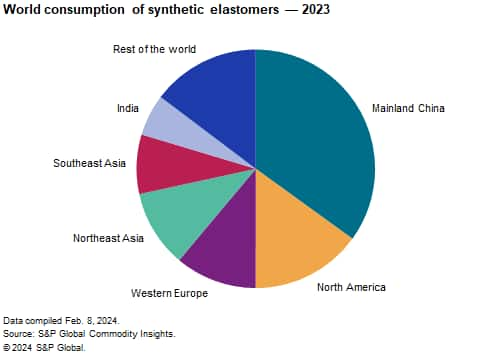Published March 2024
This report is intended to serve as a world overview of elastomer supply and demand; however, the various CEH reports on each of the individual elastomers should be considered the definitive source of data and information for each material. This report includes the following large-volume synthetic elastomers, which are referred to as general purpose elastomers: butyl, ethylene-propylene, nitrile (excluding latex), polybutadiene, polychloroprene (neoprene), polyisoprene, styrenic block copolymers and styrene-butadiene (SBR). This report does not cover styrene-butadiene latexes nor nitrile elastomer latexes.
The following pie chart shows world consumption of synthetic elastomers:

For more detailed information, see the table of contents, shown below.
S&P Global’s Chemical Economics Handbook – Elastomers Overview is the comprehensive and trusted guide for anyone seeking information on this industry. This latest report details global and regional information, including

S&P Global’s Chemical Economics Handbook – Elastomers Overview has been compiled using primary interviews with key suppliers, organizations and leading representatives from the industry in combination with S&P Global’s unparalleled access to upstream and downstream market intelligence, expert insights into industry dynamics, trade and economics.
This report can help you:
- Identify trends and driving forces influencing chemical markets
- Forecast and plan for future demand
- Understand the impact of competing materials
- Identify and evaluate potential customers and competitors
- Evaluate producers
- Track changing prices and trade movements
- Analyze the impact of feedstocks, regulations, and other factors on chemical profitability

















